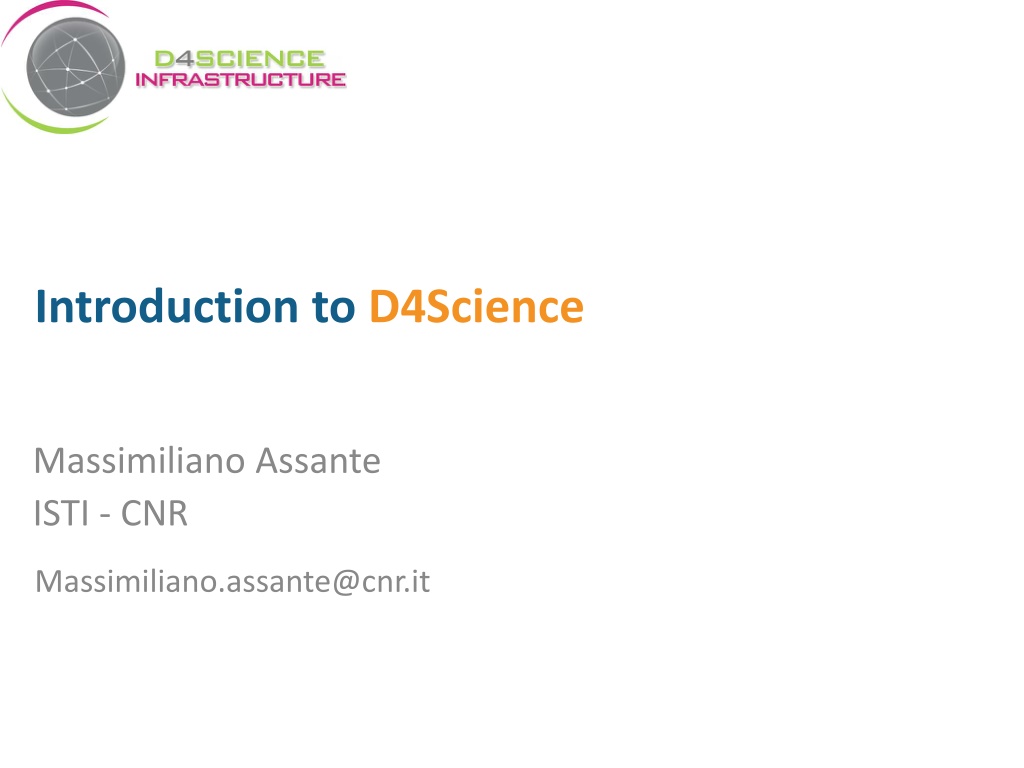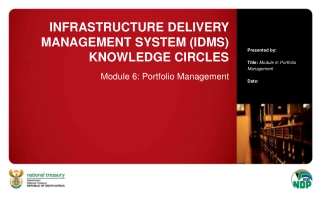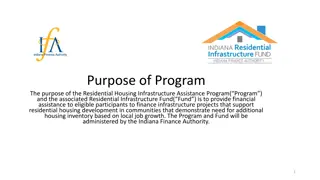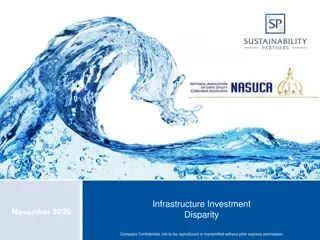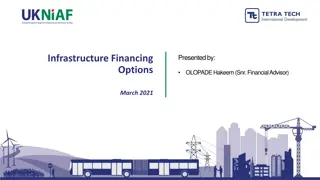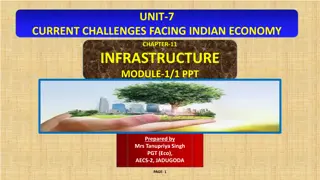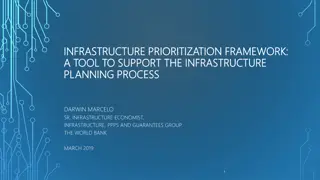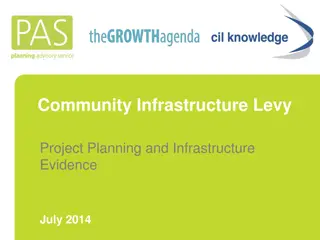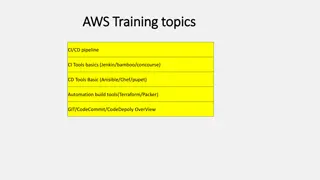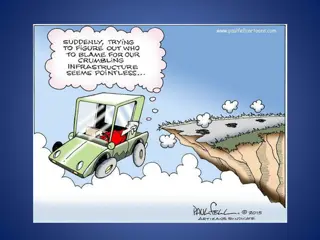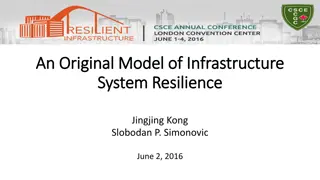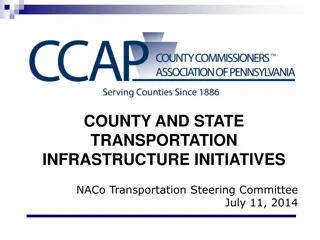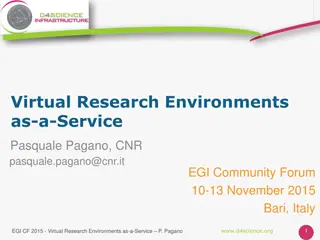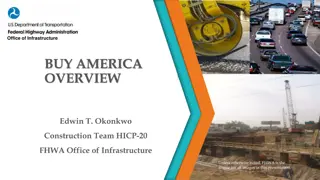Exploring the Innovative D4Science Infrastructure
Dive into the cutting-edge D4Science infrastructure, a powerful platform seamlessly integrating over 500 software components to connect thousands of scientists worldwide. Discover how it offers vast data resources, access to quality records, and a plethora of Virtual Research Environments tailored to various scientific communities. Explore its utilization of cloud-computing technologies for efficient data management and its robust services like Storage as a Service and Applications as a Service for data curation and exchange.
Download Presentation

Please find below an Image/Link to download the presentation.
The content on the website is provided AS IS for your information and personal use only. It may not be sold, licensed, or shared on other websites without obtaining consent from the author. Download presentation by click this link. If you encounter any issues during the download, it is possible that the publisher has removed the file from their server.
E N D
Presentation Transcript
Introduction to D4Science Massimiliano Assante ISTI - CNR Massimiliano.assante@cnr.it www.bluebridge-vres.eu
The D4Science infrastructure Data Infrastructure combining over 500 software components into a coherent and centrally managed system of hardware, software, and data resources 23/09/2024 Introduction to Existing Technologies and Enabling Platform - M. Assante 2
D4Science Identity D4Science is connecting +3900 scientists in 44 countries integrating data from +50 heterogeneous providers executing +50,000 models & algorithms/month providing access to over a billion quality records in repositories worldwide operating with 99,7% service availability D4Science hosts 95 Virtual Research Environments to serve the biological, ecological, environmental, social mining, culture heritage, and statistical communities world-wide. 23/09/2024 Introduction to Existing Technologies and Enabling Platform - M. Assante 3
D4Science for Geeks uses cloud-computing technologies to manage +300 servers (more than 5 TB Ram, +1700 CPUs, 400 TB storage) is monitored via Nagios and Ganglia is maintained via Ansible (Application Deployment + Configuration Management + Continuous Delivery) is governed by deployment and operation policies has established SLA is operated according to defined Terms of Use 23/09/2024 Introduction to Existing Technologies and Enabling Platform - M. Assante 4
Storage as Service to host and maintain data Database High-availability Standard Ready-to-use Cloud Storage Scalable Reliable Secure Geographical DB Scalable OGC Standard Privacy and Attribution 23/09/2024 Introduction to Existing Technologies and Enabling Platform - M. Assante 5
Applications as a Service to curate and manage data Metadata Generation Geospatial Data Biodiversity Data Statistical Data Textual Data Harmonization Disambiguate Validate Data Exchange OGC protocols DarwinCore SDMX DublinCore Integrate and Consistency Check 23/09/2024 Introduction to Existing Technologies and Enabling Platform - M. Assante 6
Computing as Service to process and extract knowledge Scalable Easy to Manage Across Boundaries Tailored Elastic Rich and Heterogeneous High Throughput Map-Reduce Parallel R Assignment of Computing Assignment of Processors Virtual Research Environment 23/09/2024 Introduction to Existing Technologies and Enabling Platform - M. Assante 7
Born from the user needs to host applications in a secure and scalable environment to maintain and preserve data to securely delivery data to known users Capacities to analyze datasets to manage the full data life-cycle from import to validation, curation, harmonization and publication to reduce the costs of data maintenance Applications to access authoritative datasets to mash-up data to analyse big datasets to validate datasets and provide a standard access to them Data 23/09/2024 Introduction to Existing Technologies and Enabling Platform - M. Assante 8
Virtual Research Environment to access, share and collaborate Share Communicate Post Favourite Connection Organize Database Tables Workflow Files Dynamic VRE Creation Secure Policy Control 23/09/2024 Introduction to Existing Technologies and Enabling Platform - M. Assante 9
Virtual Research Environment a distributed and dynamically created environment where subset of resources (data, services, computational, and storage resources) regulatedby tailored policies are assigned to a subset of users via interfaces for a limited timeframe at little or no cost for the providers of the participatory data e-infrastructures L. Candela, D. Castelli, P. Pagano (2013) Virtual Research Environments: An Overview and a Research Agenda. Data Science Journal, Vol. 12 23/09/2024 Introduction to Existing Technologies and Enabling Platform - M. Assante 10
Supported projects full list at https://services.d4science.org/explore 23/09/2024 Introduction to Existing Technologies and Enabling Platform - M. Assante 11
References / Links D4Science Web Site: http://www.d4science.org D4Science for developers: http://dev.d4science.org Catalogue of Applications https://www.gcube-system.org/catalogue-of-applications Software Key Features https://wiki.gcube-system.org/GCube_Features Developer Guide https://wiki.gcube-system.org/Developer%27s_Guide FeatherWeightStack https://wiki.gcube-system.org/Featherweight_Stack SmartGears https://wiki.gcube-system.org/SmartGears gCube APIs https://wiki.gcube-system.org/GCube_Application_Programming_Interface Administration Guide https://wiki.gcube-system.org/Administrator%27s_Guide 23/09/2024 Introduction to Existing Technologies and Enabling Platform - M. Assante 12
